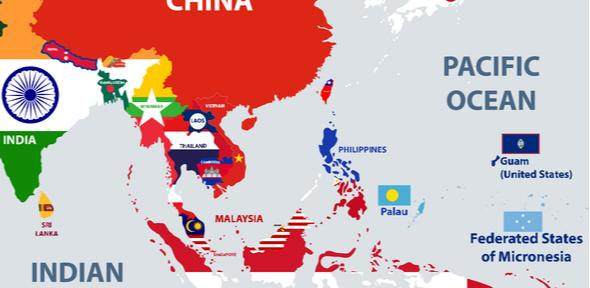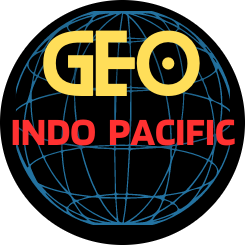
The Indo-Pacific region has emerged as the new geopolitical hotspot, with major global powers vying for influence over its strategic waterways, economic opportunities, and military dominance. As tensions rise between established powers like the U.S. and China and emerging players such as India, Japan, and ASEAN nations, the question remains: Who will ultimately dominate the Indo-Pacific?
The Key Contenders
1. United States: The Incumbent Superpower
The U.S. has long been the dominant force in the Pacific through its military alliances (Japan, South Korea, Australia, and the Philippines) and economic partnerships. The “Pivot to Asia” strategy under Obama and the Indo-Pacific Strategy under Biden reinforce America’s commitment to countering China’s expansion.
- Strengths:
- Strong military presence (U.S. Pacific Fleet, bases in Japan & Guam).
- Strategic alliances (Quad, AUKUS).
- Economic leverage via trade and technology controls.
- Challenges:
- Overstretched global commitments (Ukraine, Middle East).
- Domestic political divisions affecting foreign policy consistency.
2. China: The Rising Challenger
China’s rapid military modernization, Belt and Road Initiative (BRI), and aggressive territorial claims (South China Sea, Taiwan) make it the primary challenger to U.S. dominance.
- Strengths:
- Economic influence (largest trading partner for most ASEAN nations).
- Growing naval power (aircraft carriers, hypersonic missiles).
- Debt diplomacy and infrastructure investments.
- Challenges:
- Economic slowdown (real estate crisis, trade wars).
- Distrust among neighbors (India, Japan, Australia).
3. India: The Emerging Balancer
India’s “Act East Policy” and military modernization position it as a key player. Its participation in the Quad (with U.S., Japan, Australia) and defense partnerships signal its strategic importance.
- Strengths:
- Fast-growing economy and demographic advantage.
- Strategic location controlling Indian Ocean trade routes.
- Stronger defense ties with Western powers.
- Challenges:
- Infrastructure and military modernization delays.
- Dependency on Russian arms amid Western pressure.
4. Japan & Australia: Middle Powers with Strategic Roles
- Japan is expanding its military capabilities (counterstrike missiles, defense budget hikes) and deepening alliances.
- Australia, through AUKUS, is bolstering its submarine fleet to counter Chinese influence.
5. ASEAN: The Decisive Swing Factor
ASEAN nations (Indonesia, Vietnam, Philippines) seek to balance between U.S. and China without overtly picking sides. Their neutrality or alignment will shape the region’s future.
Who Will Win?
The Indo-Pacific power struggle is unlikely to have a single winner. Instead, we may see:
- A Bipolar Standoff (U.S. vs. China): Continued competition with smaller nations hedging bets.
- Multipolar Order: India, Japan, and ASEAN playing balancing roles, preventing outright dominance by any one power.
- Economic vs. Military Influence: China may lead economically, while the U.S. retains military superiority.
The Indo-Pacific’s future will be shaped by alliances, economic interdependence, and military deterrence. While China seeks to displace U.S. influence, America’s alliances and India’s rise could ensure a balanced, multipolar region rather than a single hegemon. The real “winner” may be whichever power can secure the trust of smaller nations while avoiding outright conflict.
The strategic competition between China and the United States in the Indo-Pacific region has become one of the most significant geopolitical dynamics of the 21st century. As China’s economic and military power grows, questions arise about whether it can displace the U.S. as the dominant force in this critical region.
China’s Growing Influence
China has made substantial gains in the Indo-Pacific through:
- Economic leverage: The Belt and Road Initiative and trade relationships give Beijing influence over many regional economies
- Military expansion: Rapid modernization of the PLA Navy and construction of artificial islands in the South China Sea
- Diplomatic efforts: Strengthening ties with ASEAN nations and Pacific Island countries
U.S. Strengths and Responses
The United States maintains advantages through:
- Alliance networks: Strong partnerships with Japan, South Korea, Australia, and others
- Military presence: Numerous bases and naval superiority (for now)
- Technological edge: Superior defense and surveillance capabilities
- Regional initiatives: The Indo-Pacific Strategy and partnerships like the Quad (with India, Japan, Australia)
Key Factors That Will Determine the Outcome
- Economic competition: Who can offer better development opportunities to regional nations
- Military balance: Naval power projection capabilities in contested waters
- Alliance politics: Whether countries choose to align with Washington, Beijing, or remain neutral
- Technological leadership: Especially in areas like AI, cyber, and space capabilities
- Domestic stability: Both nations face internal challenges that could affect their external focus
Potential Outcomes
Most analysts suggest complete dominance by either power is unlikely. More probable scenarios include:
- A prolonged period of tense coexistence with spheres of influence
- Gradual Chinese predominance in some sub-regions coupled with enduring U.S. alliances
- The potential for conflict if competition escalates uncontrollably
The ultimate “winner” may not be determined by military or economic metrics alone, but by which power can offer the more compelling vision for regional order and stability. The coming decade will likely prove decisive in shaping the Indo-Pacific’s future balance of power.





